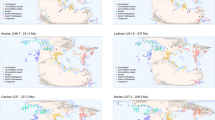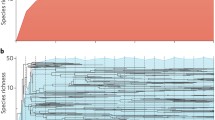Abstract
The observed local range of a fossil taxon in a stratigraphic section is almost certainly a truncated version of the true local range. True endpoints are parameters that may be estimated using only the assumption that fossil finds are distributed randomly between them. If thickness is rescaled so that true endpoints lie at 0 and 1, the joint distribution of gap lengths between fossil finds is given by the Dirichlet distribution. Observed ends of the range are maximum likelihood estimators of true endpoints, but they are biased seriously. Extension of the observed range at each end by a distance equal to the average gap length yields unbiased point estimators. Classical statistics can generate confidence intervals for ends of the taxon range; but with Bayesian inference, the probability that true endpoints lie in a certain region can be stated. For a 95% confidence level (classical) or a 95% probability (Bayesian), the range extensions exceed the observed range if the range is established on less than six finds; if only two finds are used, such range extensions are an order of magnitude longer than the observed range. Evidently the standard biostratigraphic practice that identifies zonal boundaries as horizons rather than confidence intervals may not be justified at the resolution of typical fossiliferous sections.
Similar content being viewed by others
References
Edwards, Lucy E., 1982, Quantitative Biostratigraphy: The Methods Should Suit the Data: p. 45–60,in Cubitt, J. M. and Reyment, R. A. (eds.),Quantitative Stratigraphic Correlation: Wiley, Chichester.
Hazel, J. E., 1977, Use of Certain Multivariate and Other Techniques in Assemblage Zonal Biostratigraphy: Example Utilizing Cambrian, Cretaceous, and Tertiary Benthic Invertebrates: p. 187–212,in Kauffman, E. G. and Hazel, J. E. (eds.),Concepts and Methods of Biostratigraphy: Dowden, Hutchinson and Ross, Stroudsborg, Pennsylvania.
Hogg, R. V. and Craig, A. T., 1978,Introduction to Mathematical Statistics: Macmillan, New York, 438 p.
Huber, Brian T., 1986, The Location of the Cretaceous-Tertiary Contact on Seymour Island, Antarctic Peninsula:Antarctic J. USA, v. 20(5), p. 46–48.
Lindley, D. V., 1980,Introduction to Probability and Statistics from a Bayesian Viewpoint, Parts I and II (2nd ed.): Cambridge University Press, Cambridge, England, 270 p. and 300 p.
Macellari, Carlos E., 1986, Late Campanian-Maastrichtian Ammonite Fauna from Seymour Island (Antarctic Peninsula):J. Paleont., v. 60, II, p. 1–55.
McKinney, M. L., 1986, How Biostratigraphic Gaps Form:J. Geol., v. 94, p. 875–884.
Paul, C. R. C., 1982, The Adequacy of the Fossil Record: p. 75–117,in Joysey, K. A. and Friday, A. E. (eds.),Problems of Phylogenetic Reconstruction: Academic Press, London and New York.
Ross, S. M., 1984, Introduction to Probability Models: 3rd ed.: Academic Press, New York, 272 p.
Sadler, Peter M., 1989, Geometry and Stratification of Uppermost Cretaceous and Paleogene Units on Seymour Island, Northern Antarctic Peninsula,in Feldmann, R. M. and Woodburne, M. O. (eds.),The Geology of Seymour Island, Antarctica: Geological Society of America, Memoir 169, p. 303–320.
Shaw, A. B., 1964,Time in Stratigraphy: McGraw-Hill, 365 p.
Signor, P. W. and Lipps, J. H., 1982, Sampling Bias, Gradual Extinction Patterns and Catastrophes in the Fossil Record: p. 291–296,in Silver, L. T. and Schultz, P. H. (eds.),Geological Implications of Impacts of Large Asteroids and Comets on the Earth: Geological Society of America, Special Paper 190.
Springer, M. and Lilje, A., 1988, Biostratigraphy and Gap Analysis: The Expected Sequence of Biostratigraphic Events:J. Geol., v. 96, p. 228–236.
Author information
Authors and Affiliations
Rights and permissions
About this article
Cite this article
Strauss, D., Sadler, P.M. Classical confidence intervals and Bayesian probability estimates for ends of local taxon ranges. Math Geol 21, 411–427 (1989). https://doi.org/10.1007/BF00897326
Received:
Accepted:
Issue Date:
DOI: https://doi.org/10.1007/BF00897326




